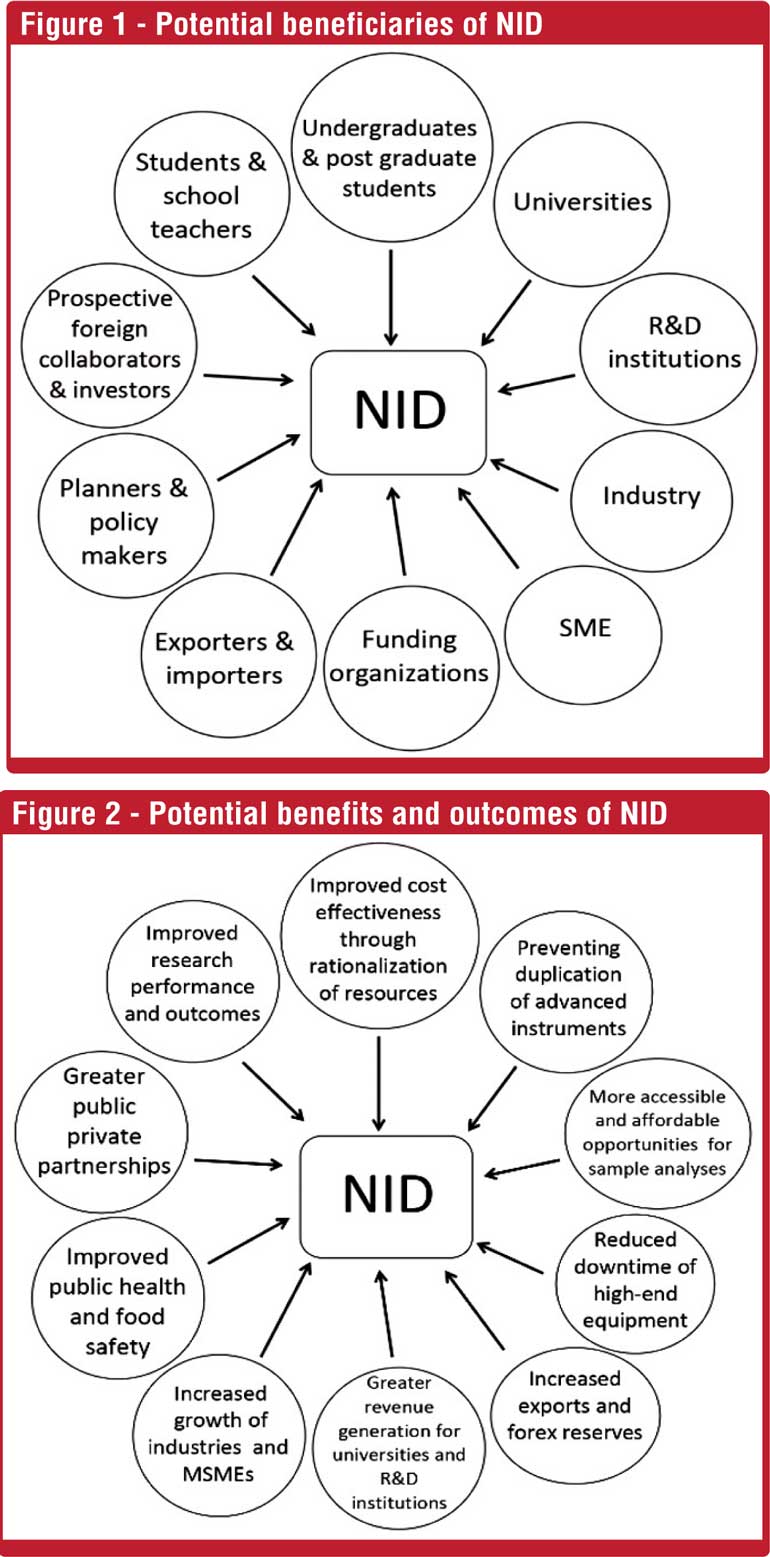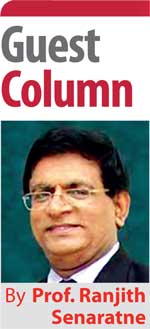Wednesday Jan 14, 2026
Wednesday Jan 14, 2026
Wednesday, 14 September 2022 00:10 - - {{hitsCtrl.values.hits}}
 The National Science Foundation is the premier national institution mandated to promote science, technology and innovation for socio-economic development of the country. In keeping with its mandate and in order to advance a digital economy in Sri Lanka, the NSF recently embarked upon several novel initiatives. They included, among others, establishment of a global digital platform (GDP) to harness Sri Lankan expatriate scientists, technologists, entrepreneurs and professionals for national development; construction of a national instrument database (NID) to promote R&D, industrial growth and exports; and taking steps for establishing a national digital library to provide academics and scientists with increased user-friendly access to scientific journals and databases in a cost-effective manner.
The National Science Foundation is the premier national institution mandated to promote science, technology and innovation for socio-economic development of the country. In keeping with its mandate and in order to advance a digital economy in Sri Lanka, the NSF recently embarked upon several novel initiatives. They included, among others, establishment of a global digital platform (GDP) to harness Sri Lankan expatriate scientists, technologists, entrepreneurs and professionals for national development; construction of a national instrument database (NID) to promote R&D, industrial growth and exports; and taking steps for establishing a national digital library to provide academics and scientists with increased user-friendly access to scientific journals and databases in a cost-effective manner.
Sri Lanka has over 20 State-owned higher education institutions, a comparable number R&D institutions, and several public sectors institutions, such as Sri Lanka Atomic Energy Board, Sri Lanka Standard Institute and Board of Investment, which collectively possess an immense instrument base including high-end equipment, most of which has been purchased using public funds. Much of this equipment is meant to be used on a 24x7 basis, as is done in many parts of the world. However, due to compartmentalisation and fragmentation of institutions, the “possessive attitude” of many scientists, the lack of a sharing culture, and the absence of an institutional policy and mechanism for providing analytical and testing services to external institutions and persons, many expensive items of advanced equipment and instruments purchased operate far below their capacity.
 Thus, they remain underutilised and inaccessible to stakeholders who need to analyse and test food and beverages, soil, industrial effluents, water and air, to name but a few. Moreover, given the rapid advances in the field of analytical technology, some equipment become obsolete relatively fast. Underutilisation of such equipment, therefore, constitutes a decided cost and waste of public funds, especially when purchased using limited foreign exchange.
Thus, they remain underutilised and inaccessible to stakeholders who need to analyse and test food and beverages, soil, industrial effluents, water and air, to name but a few. Moreover, given the rapid advances in the field of analytical technology, some equipment become obsolete relatively fast. Underutilisation of such equipment, therefore, constitutes a decided cost and waste of public funds, especially when purchased using limited foreign exchange.
On the other hand, providing such a service to stakeholders for a reasonable fee, besides generating revenue for the institution and helping to make the most of the hitherto underutilised instruments, will meet a longstanding need of industries, including micro, small and medium enterprises, which neither have the capacity to invest in expensive equipment nor the competency to maintain it in order to carry out the requisite tests before releasing their products to the local, regional and global markets.
Therefore, the NSF took steps to develop a user-friendly, state-of-the-art data base of analytical, testing and research equipment available in state higher education and R&D institutions with a view to providing much needed services and support to its stakeholders both in the public and private sectors in a cost-effective manner. This will undoubtedly constitute another landmark in the annals of the almost 55-year journey of the NSF in affording a new momentum and boost to science, technology and innovation (STI), industry and exports of the country.
Salient features of NID
This database will contain information on the type of equipment, its model, year of manufacture, analytical and testing capabilities, location by means of a Google map, turn-around time for sample analysis, cost of analysis, contact details, etc. It is constructed in a user-friendly manner so that even a non-technical person can easily access it by indicating either the test required, for example aflatoxin, E. coli bacteria or heavy metal, or the name of equipment needed. This will enable him or her to find out the closest place available for sample analysis in a cost-effective and time-efficient manner. For instance, an industry, SME or a farmer in Mulative may not need to send samples to Colombo for analysis, but could get that done at the University of Jaffna or the University of Vavuniya, thereby avoiding a lot of hassle as well.
The NID will have information on analytical and testing facilities and parameters relevant to a wide range of samples, including ones of soil, water, air, food and beverage products, industrial pollution, food contamination, food safety, food hygiene and material.
Expected benefits and outcomes
Stakeholders ranging from schoolchildren, teachers, students, postgraduate students and scientists to industry, planners, policymakers, academia, R&D institutions, and exporters and importers will benefit from it (Fig. 1).
Due to the health and safety risks posed by chemical, microbiological and environmental contaminants, analytical methods are increasingly becoming a centrepiece of food safety programs. Today, consumers are becoming increasingly health-conscious, and importing countries, particularly the developed ones, have laid down stringent compliance requirements which have to be met when importing food and beverages products. Maximum residue levels (MRLs) laid down by the Commission du Codex Alimentarius in France are used by many countries. In the USA, the Food and Drug Administration (FDA) sets action levels that specify maximum levels of specific contaminants that may be found in a food sample. For instance, it is 20 parts per billion for aflatoxin (ppb) for food and animal feed, and the sale or export of any such material exceeding this value is not permitted in the USA.
The NID, with its diverse and wide instrument base, will pave the way for establishing the required compliance infrastructure and capabilities in Sri Lanka. These will, among other things, promote exports, thereby enhancing foreign exchange reserves. This facility can also be used to monitor the quality of imported food and feed to the country, which is of prime importance given the spate of unhealthy and harmful imports to the country in the recent past. The import of large quantities of coconut oil contaminated with aflatoxin and fertilisers contaminated with heavy metal are two poignant examples.
This will ensure that edible products, both exported and imported, will be free of biological (e.g. salmonella, E. coli bacteria, etc.), chemical (e.g. pesticide residue, food additives, adulterants, etc.) and physical (e.g. glass, pieces of metal, plastic or wood, etc.) hazards. This will protect public health and ensure the safety of consumers, and build the confidence of importers of Sri Lankan products, which will contribute to increasing forex reserves though improved exports and tourism.
Further, the NSF will work closely with institutions such Sri Lanka Standards Institution (SLSI), Sri Lanka Accreditation Board (SLAB) and Measurement Units Standards and Services Department (MUSSD) to have few selected laboratories accredited initially as per ISO/IEC 17025 standard in line with the high priority needs of the country concerning the key exports and imports. This will obviate any chance of shipments from Sri Lanka being returned due to non-compliance. This failure of compliance has, in the recent past, had a negative impact on Sri Lankan exports in a fiercely competitive globalised environment, and resulted in the payment of heavy demurrage to ships on account of the long turn-around time taken for quality testing.
As indicated before, rationalisation of resources, avoiding unnecessary duplication of advanced expensive instruments, and generating revenue for the host institutions are other advantages of the NID. The latter can, to some degree, ease the financial constraints faced due to the slashing of the financial allocation at the advent of the current economic crisis. Moreover, the NID, through provision of analytical and testing services to industry, including MSME, will help to develop a close rapport and understanding with them which will facilitate forging strategic public-private partnerships that will lead to more patents, greater commercialisation of new discoveries and innovations.
In addition, the NID will provide more accessible and affordable opportunities for sample analyses resulting in improved cost-effectiveness and reduced turnaround time. This will thereby enhance the research culture, research accomplishments and the output of postgraduates in higher education institutions in the country (Fig. 2).
Interventions needed to ensure sustainability of the NID and derive its potential benefits
As stated before, there are over 20 State-owned universities, a comparable number of R&D institutions and several public sectors institutions with well-equipped laboratories and analytical and testing facilities relevant to their mandates. However, they are scattered over a plethora of ministries and are heavily compartmentalised with poor interinstitutional cooperation. Therefore, there is hardly any sharing of resources, both human and physical, across institutional boundaries.
This structural problem has posed a constraint on obtaining the required information from several institutions for the NID, despite its national importance. Therefore, through appropriate policy intervention, it should be made mandatory for all State institutions to provide information on the instruments and equipment available along with technical specifications on their respective institutional websites for the benefit of the key stakeholders and the general public.
Moreover, our country lacks a database of the technical workforce competent in the repair and maintenance of high-end equipment. Consequently, the downtime of such equipment is rather high, and valuable equipment becoming dysfunctional due to minor technical issues is not infrequent. Therefore, the NSF with the support of relevant institutions will build a national database of technical staff, both working and retired, competent in the maintenance and repair of research, analytical and testing instruments. This will ensure an almost zero downtime and an uninterrupted service to the stakeholders.
Analytical service is a huge, lucrative and growing industry in the world. Sri Lanka, endowed with high-end instruments in its R&D institutions and universities, world-class scientists in analytical testing, and a strategic location in the Indian Ocean, has the promise to become a regional hub for analytical services. Establishment of the NID and accreditation of service laboratories as per the ISO/IEC 17025 standard, augmented with appropriate policy interventions, could make that goal attainable.
The NID is the culmination of a concerted and concentrated effort on the part of the dedicated NSF staff, ably guided and led by a team of outstanding scientists including Dr. Chandra Embuldeniya, Chairman of the Technology Development and Innovation Arm of the NSF and Dr. Nanda Gunawardhana, Director, Research and International Affairs, SLTC. The NSF is grateful to them for their invaluable contribution in constructing a state-of-the-art national instrument database which will be launched on 14 September 2022 at Isurupaya under the patronage of Dr. Susil Premajayantha, Minister of Education. The NID will be a game changer in the S&T sector of the country with far-reaching potential benefits for the Sri Lankan economy.
(The writer is the Chairman at the National Science Foundation.)